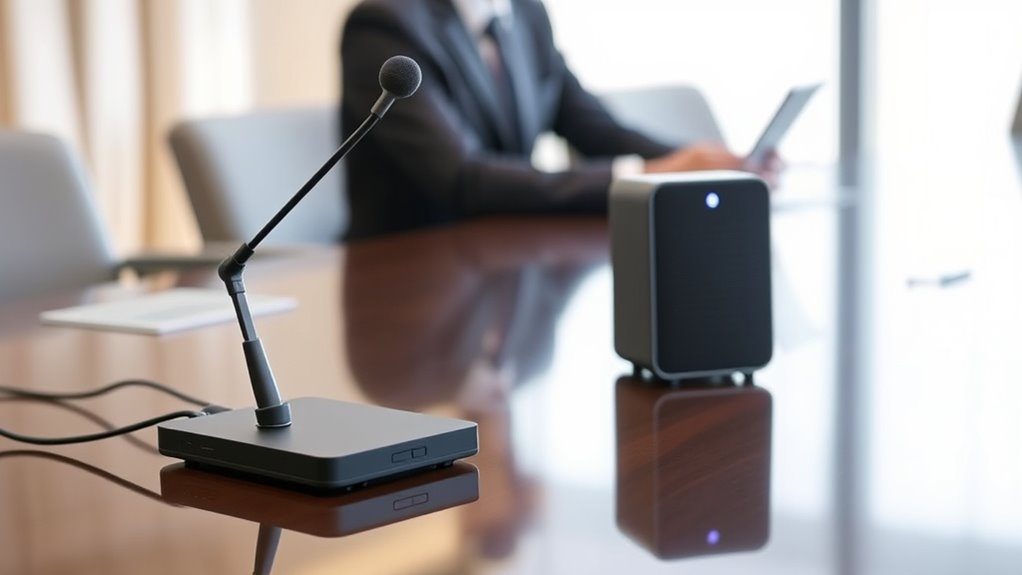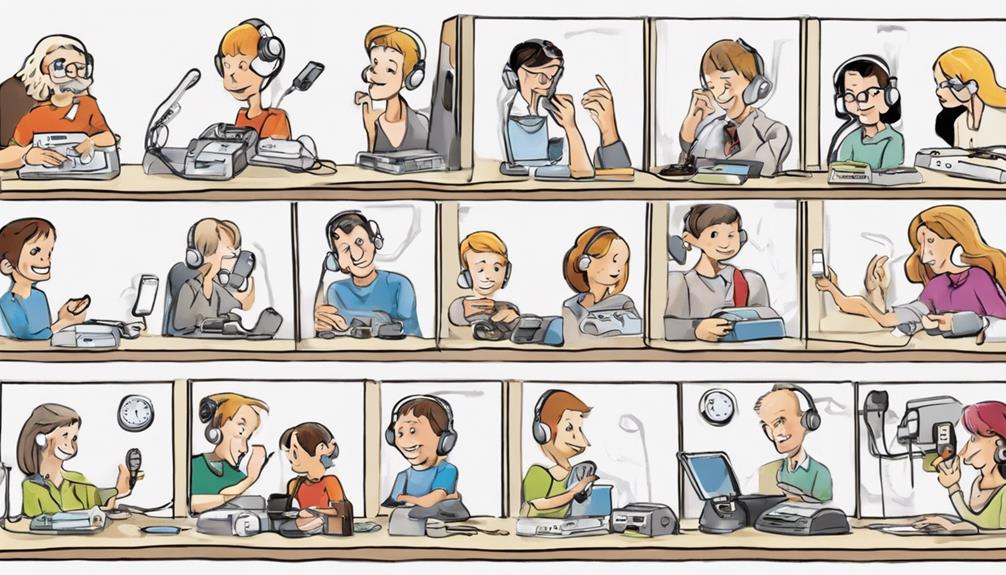When choosing a portable loop system for meetings, focus on reliable wireless connectivity, portability, and user-friendly controls. Pick a system compatible with your hearing aids or assistive devices and suited to your meeting space size. Look for long battery life and durable construction to guarantee dependability. Cost-effectiveness and easy setup matter too. Keep these factors in mind, and you’ll discover how to select the best option for your needs. Explore further to find the right fit.
Key Takeaways
- Prioritize reliable wireless connectivity, compact design, and user-friendly controls for seamless, portable meeting setups.
- Choose systems suited to your room size and layout, considering space coverage and microphone placement.
- Ensure compatibility with hearing aids and assistive devices for clear, accessible communication.
- Opt for long-lasting batteries and durable construction to support frequent use and outdoor environments.
- Select reputable brands with good warranty and support to guarantee reliable performance and ongoing assistance.
Understanding Portable Loop System Basics

A portable loop system is a compact device designed to help individuals with hearing aids or cochlear implants easily hear speech in various settings. It works by transmitting sound directly to your hearing device via magnetic induction, reducing background noise. Wireless connectivity is a key feature, allowing you to connect effortlessly to microphones, smartphones, or other audio sources without cables. This makes setup simple and convenient for meetings or social gatherings. Battery life is another important aspect; a good portable loop system should last through your entire event without needing frequent recharging. Some models offer rechargeable batteries, while others use replaceable ones. Understanding these basics guarantees you choose a device that fits your needs and enhances your listening experience wherever you go. Color accuracy in the device’s transmission can also influence sound clarity and overall experience.
Key Features to Look For

When choosing a portable loop system, you want features that make setup quick and simple. Look for models that are lightweight and easy to transport, so you can move them effortlessly between rooms. Ensuring they are straightforward to install means fewer headaches during meetings and more focus on your audience.
Key Features to Look For
Choosing the right portable loop system hinges on identifying key features that enhance usability and performance. Look for reliable wireless connectivity, ensuring seamless audio transmission without interruptions. Strong, stable connections make meetings smoother and more efficient. Additionally, consider the aesthetic design—compact, sleek, and unobtrusive units blend well into any environment, creating a professional atmosphere. Ease of operation is also crucial; user-friendly controls and clear indicators reduce setup time and confusion. Durability matters, too; select systems built with quality materials to withstand frequent transport and use. Battery life should support long meetings, and compatibility with various hearing aids and assistive listening devices ensures accessibility. Paying attention to system compatibility guarantees that the loop system integrates well with existing assistive devices, making it more versatile. Focusing on these key features helps you find a system that’s both functional and discreet.
Portability and Ease of Setup
Portability and ease of setup are essential considerations when selecting a portable loop system. You want a device that’s lightweight and compact enough to carry comfortably and set up quickly. Look for systems with wireless connectivity, which eliminates the need for tangled cables and simplifies installation. A system with long battery life ensures you won’t be interrupted mid-meeting, especially if power outlets aren’t readily available. Choose a model that’s intuitive to operate, with minimal setup steps, so you can focus on your meeting rather than troubleshooting. The right system combines portability with straightforward setup, making it convenient to transport and ready to use in any venue. Prioritizing these features guarantees a seamless experience for both you and your audience.
Types of Loop Systems Suitable for Meetings
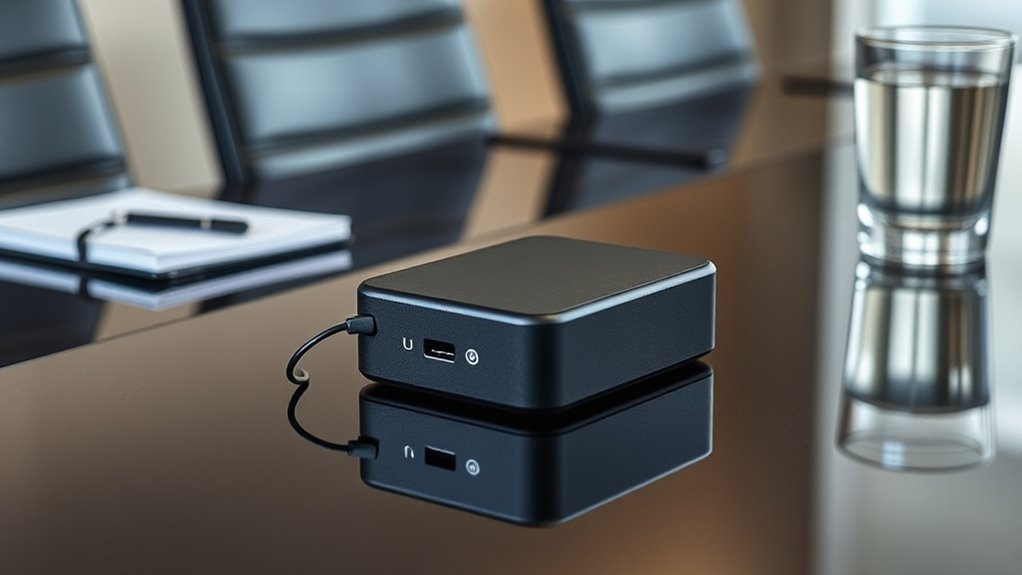
There are several types of loop systems designed specifically for meetings, each offering different features to suit various needs. These systems use wireless technology to guarantee seamless sound amplification without clutter or wiring. Here are three common options:
- Induction Loop Systems: Perfect for small to medium meetings, these create a magnetic field that directly transmits sound to hearing aids with telecoils.
- Infrared Loop Systems: Ideal for multi-room setups, they use infrared light to deliver clear audio, minimizing interference.
- Bluetooth Loop Systems: Designed for personal use, they connect wirelessly to smartphones or hearing aids, offering mobility and convenience.
Choosing the right type depends on your space, audience size, and specific sound amplification needs. Considering advancements like wireless technology integration can further enhance system performance and user experience.
Assessing Your Meeting Space Needs

To effectively select a loop system for your meeting, start by evaluating the specific characteristics of your space. Consider its size, shape, and layout, as these factors influence wireless connectivity and microphone placement. Larger or irregularly shaped rooms may need more extensive coverage or multiple loop segments. Guarantee the system can be easily moved or adjusted based on your setup needs. Proper microphone placement is essential for clear sound transmission; position microphones to minimize feedback and dead spots. Use this quick reference to assess your space:
| Space Size | Microphone Placement Needs |
|---|---|
| Small, enclosed | Close to speakers, avoid obstructions |
| Medium, open | Elevated microphones, wide coverage |
| Large, irregular | Multiple microphones, flexible loops |
Additionally, evaluating the room acoustics can help determine the most effective system configuration.
Compatibility With Hearing Aids and Assistive Devices
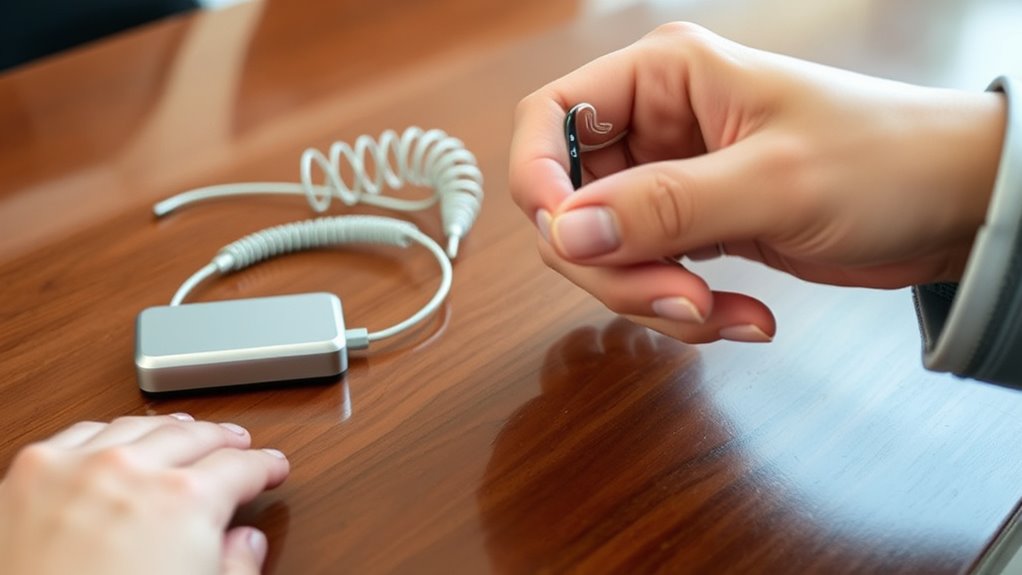
When choosing a portable loop system, it’s important to take into account hearing aid compatibility standards and how well it works with your assistive devices. You’ll want to make certain the system provides clear signals within the necessary range for your needs. By understanding these points, you can select a system that enhances sound clarity and works seamlessly with your hearing technology. Additionally, considering the diverse designs and materials available can help ensure the system complements your environment and personal preferences.
Hearing Aid Compatibility Standards
Hearing aid compatibility standards guarantee that portable loop systems work effectively with hearing aids and assistive listening devices. These standards are essential because they make certain your devices meet specific compatibility regulations, making communication smoother. To understand how they help, consider these points:
- They verify that the system’s signals won’t interfere with your hearing aid’s function.
- They establish minimum transmission quality for clear sound.
- They ensure the system works with various hearing aid models and brands.
- Certified devices often meet these standards, ensuring reliable performance and user satisfaction.
Assistive Device Integration
Since portable loop systems are designed to enhance communication, guaranteeing they work seamlessly with hearing aids and other assistive devices is vital. Look for systems with reliable wireless connectivity that easily pair with various hearing aids, especially those with telecoil functionality. Compatibility varies between devices, so check if your hearing aids support direct connection or require an intermediary device. Battery life is also essential; a system with long-lasting power ensures uninterrupted use during meetings. Some systems offer rechargeable options, reducing downtime and maintenance. Confirm that the loop system’s assistive device integration is straightforward, allowing you to switch between devices effortlessly. Additionally, understanding device compatibility and ensuring the system supports your specific hearing aid model can greatly improve user experience. By choosing a system with strong wireless connectivity and solid battery life, you’ll maximize usability and ensure clear communication in any meeting environment.
Signal Clarity and Range
Ensuring your portable loop system provides clear audio depends heavily on its signal clarity and compatibility with your hearing aids or assistive devices. To maximize performance, consider these key factors:
- Wireless technology: Choose systems with advanced wireless tech to reduce interference and improve clarity.
- Range: Ensure the system offers sufficient range so you can move freely without losing signal quality.
- Battery life: Opt for models with long-lasting batteries, so you avoid interruptions during meetings or events.
- Compatibility considerations: Be aware of how different wireless technologies may affect cheating detection and overall system performance.
A system with strong signal clarity and broad range guarantees your hearing aids or assistive devices pick up sound accurately. Compatibility with your devices and reliable wireless technology ensure consistent performance, making your meetings more accessible and effective.
Power Options and Portability Considerations
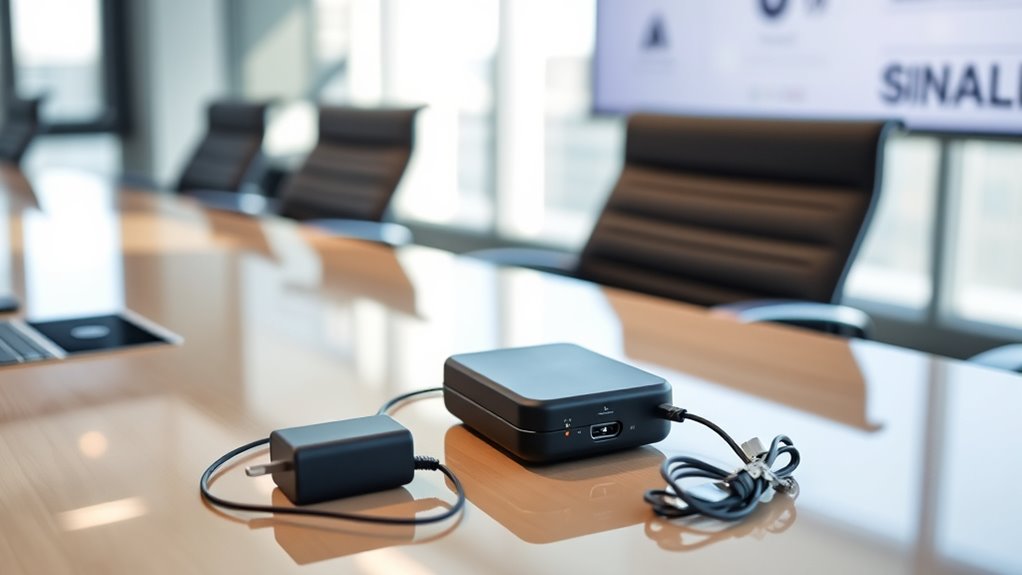
Choosing the right power options is essential for maintaining the portability of your loop system during meetings. You need to take into account battery life and the variety of power sources available. A system with long battery life ensures you won’t have to worry about frequent recharges or running out of power mid-meeting. Look for models that offer rechargeable batteries or easily replaceable batteries to extend usability. Additionally, assess the compatibility with different power sources, like AC adapters, USB power, or portable power banks, so you can adapt to various venues. Compact designs with efficient power management help keep your system lightweight and easy to transport. Overall, selecting a loop system with reliable power options guarantees uninterrupted performance no matter where your meetings take place. Incorporating data-driven strategies can help you choose the most effective power solutions based on your specific needs.
Setup and Ease of Use
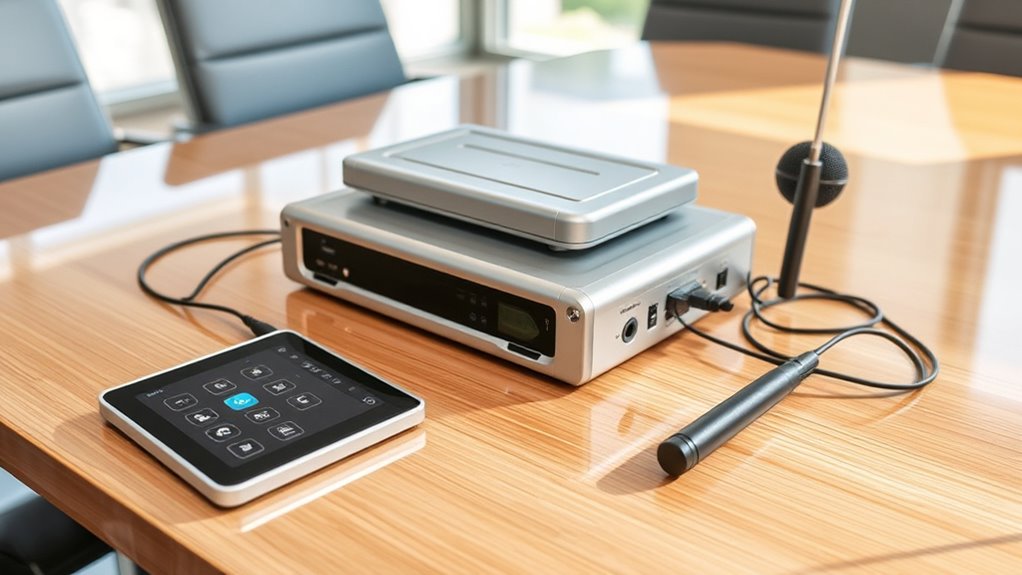
Setting up a portable loop system should be quick and straightforward so you can focus on your meeting rather than troubleshooting equipment. To guarantee smooth setup, look for systems with intuitive instructions and minimal components. Consider these key points:
Choose a portable loop system with intuitive setup for effortless meeting focus.
- Wireless connectivity: Choose a system that connects seamlessly via Bluetooth or Wi-Fi, reducing cable clutter and setup time.
- Battery life: Opt for models with long-lasting batteries to keep the system running through your entire meeting without interruptions.
- User-friendly controls: Systems with simple interfaces or remote controls make setup and operation hassle-free, even for first-time users.
Maintenance and Durability
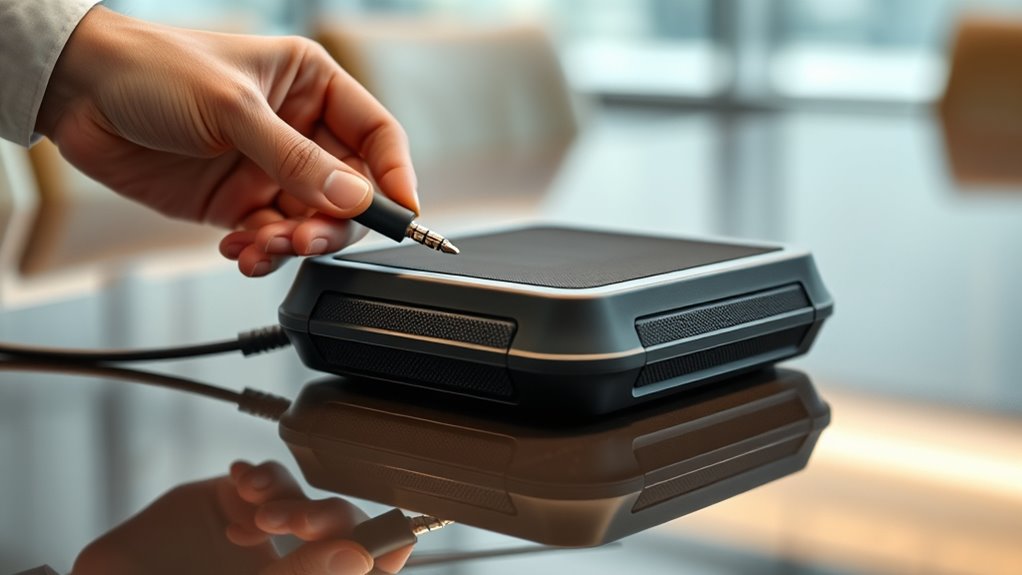
Regular maintenance is essential to keep your portable loop system functioning reliably over time. To maximize battery life, routinely check and recharge the device as recommended by the manufacturer, preventing unexpected power loss during meetings. Additionally, consider the weather resistance of your system; if you often use it outdoors or in variable conditions, ensure it’s protected from moisture and extreme temperatures. Clean the device and its connectors regularly to prevent dust and debris from affecting performance. Inspect for signs of wear or damage, especially on cables and connectors, and replace parts as needed. Proper storage when not in use also prolongs durability. For enhanced longevity, explore vetted accessories and replacement parts. By maintaining your system carefully, you’ll ensure consistent performance, extended lifespan, and reliable accessibility for everyone during meetings.
Budgeting and Cost-Effective Choices

When selecting a portable loop system, it’s important to compare costs carefully to find the best value. Look for options that offer quality features at an affordable price, so you get reliable performance without overspending. Considering both price and features helps you make cost-effective choices that suit your meeting needs.
Cost Comparison Tips
To make the most cost-effective choice in portable loop systems for meetings, start by comparing the upfront costs and long-term expenses of different options. Focus on key factors like wireless connectivity and battery life.
- Check if the system offers reliable wireless connectivity to avoid costly interruptions during meetings, which can increase overall costs.
- Evaluate battery life—longer battery life reduces the need for replacements or recharging stations, saving your budget over time.
- Consider upfront costs versus maintenance expenses; cheaper systems may have higher long-term costs due to frequent replacements or repairs.
Affordable Quality Options
Finding affordable quality portable loop systems is possible without sacrificing performance. Look for models that offer reliable wireless connectivity, so you can set up easily without tangled cords or complicated wiring. Don’t compromise on microphone quality; a clear, consistent sound ensures everyone hears the speaker clearly, regardless of the environment. Many budget-friendly options provide excellent audio clarity and decent range, making them suitable for small to medium meetings. Research brands that offer good warranties and customer support, as these often indicate reliable products. While prices vary, focus on features that matter most—like easy pairing and stable signal—rather than flashy extras. With a little research, you can find a cost-effective system that meets your needs without breaking your budget.
Making the Final Purchase Decision
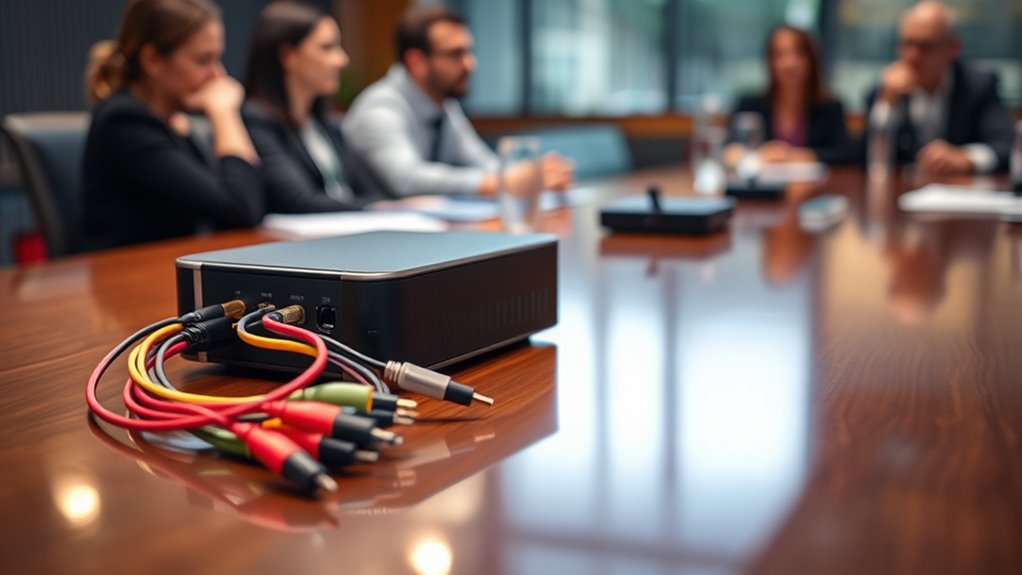
Choosing the right portable loop system involves carefully weighing your specific needs against available options. To make a confident final decision, consider these key points:
- Verify the system offers seamless Bluetooth pairing and reliable wireless connectivity to prevent audio dropouts.
- Check battery life to match your meeting durations without frequent recharges.
- Evaluate portability features like weight and size for easy transport and setup.
Focus on systems that prioritize user-friendly wireless connections and clear audio quality. A device with strong Bluetooth pairing capabilities reduces setup time, while stable wireless connectivity ensures everyone hears clearly. Don’t overlook battery life—long-lasting power keeps your meetings running smoothly. By balancing these factors, you’ll select a portable loop system that meets your needs without unnecessary complexity or cost.
Frequently Asked Questions
Are Portable Loop Systems Suitable for Outdoor Meeting Environments?
You might wonder if portable loop systems work outdoors. They can be suitable, but consider outdoor acoustics and weather resistance. Look for models with weatherproof features to withstand rain, wind, and humidity. Good outdoor performance depends on how well the system handles environmental challenges. If you choose a portable loop system with weather-resistant design, it can effectively improve hearing assistance in outdoor meeting environments, ensuring clear sound despite weather conditions.
How Long Do Portable Loop System Batteries Typically Last?
Battery life balances between busy meetings and brief bursts, typically lasting around 8 to 12 hours, depending on the system. You’ll find flexible charging options like USB ports or AC adapters that keep your system charged and ready. To maximize meeting moments, consider systems with longer-lasting batteries and easy-to-use charging methods, ensuring your portable loop system stays powered throughout your day, providing seamless sound support whenever you need it.
Can Portable Loop Systems Be Integrated With Existing Audio Equipment?
You can usually integrate portable loop systems with your existing audio equipment, thanks to their wireless compatibility. Make sure your current system supports the necessary connections or standards. This flexibility also allows for system scalability, so you can expand or upgrade without starting from scratch. Check compatibility details before purchasing, but most modern portable loop systems are designed to work seamlessly with a variety of audio setups.
What Is the Typical Setup Time for Portable Loop Systems?
You’ll find that the typical setup time for portable loop systems usually takes about 10 to 20 minutes. It involves assembling the loop system components, such as the loop wire, power supply, and connection cables, following straightforward setup procedures. Once you’ve familiarized yourself with the components and steps, you can quickly deploy the system, making it efficient for various meeting spaces.
Do Portable Loop Systems Require Professional Installation or Calibration?
Imagine setting up a lighthouse—your portable loop system needs a steady hand to guide it. You typically won’t need professional installation, as most systems feature simple setup instructions. Calibration procedures are usually straightforward, often requiring just a few adjustments to guarantee ideal sound quality. While some models might benefit from expert help, in most cases, you can confidently handle installation requirements yourself, making setup quick and hassle-free.
Conclusion
Now that you’ve got the inside scoop, choosing the right portable loop system becomes clear. Remember, it’s about finding reliable, easy-to-use tech that suits your space and budget—like having a trusty sidekick in your corner. Don’t let the hype sway you; focus on what truly fits your needs. With this guide, you’ll make a confident decision, ensuring your meetings are accessible and inclusive—just like a well-tuned orchestra, harmonizing everyone’s voices effortlessly.

